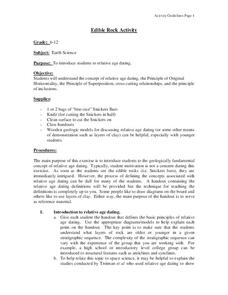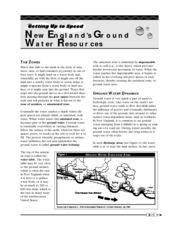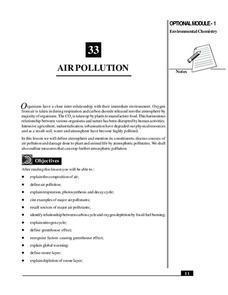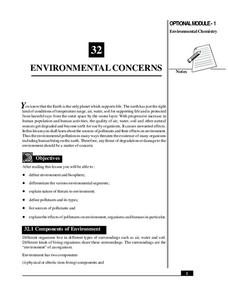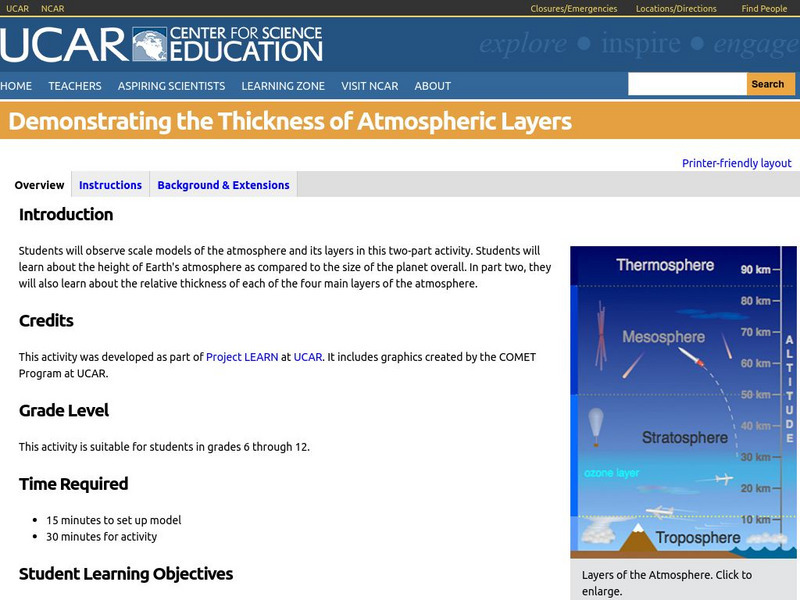Oregon State
World Map of Plate Boundaries
Young geologists piece together the puzzle of plate tectonics in an earth science lesson. Given a physical map of the world, they search for land formations that indicate the location of different types of plate boundaries.
Sunburst Visual Media
Clouds
Support science instruction with a combination of engaging activities and skills-based worksheets that focus on clouds. Learners take part in grand discussions, write an acrostic poem, complete graphic organizers, solve word...
Teach Engineering
Searching for Bigfoot and Others Like Him
Individuals create a GIS data layer in Google Earth that displays information about where one might find seven different cryptids. The class members research to find data on cryptid sightings they can include in their data...
Curated OER
First Land Plants Found on Earth
In this first land plants worksheet, students read about the major events that allowed plants to evolve on Earth. Students read about the primary and secondary atmospheres, the formation of the ozone layer to protect from UV light and...
Curated OER
Edible Rock Activity
Who knew Snickers® could be used to teach science? Give your budding earth scientists a chance to explore the Law of Superposition, in addition to a well-earned snack.
Environmental Protection Agency (EPA)
New England's Ground Water Resources
Learn all about where ground water is stored, how it moves, and how it is accessed in a detailed and thorough 10-page reading. Whether supplementing reading for an existing environmental or earth science course or providing background...
National Institute of Open Schooling
Air Pollution
Seventy percent of the air pollution in China is due to car exhaust. Under the umbrella of environmental chemistry, learners extensively explore air pollution. From the makeup of our atmosphere to sources of major air pollutants, classes...
Wilderness Classroom
Pollution
Educate scholars on pollution—air, water, and land—with a series of lessons that begin with a thorough explanation of each type. Learners then take part in three activities to reinforce the importance of reducing pollution. They...
Wilderness Classroom
Ocean Life
Our oceans are composed of many complex relationships. Young oceanographers explore relationships between organisms, understand the world ocean's currents, and discover the effects of water pollution and how it behaves. There are...
National Institute of Open Schooling
Environmental Concerns
Every year, more than 14 billion pounds of garbage is dumped into the oceans of the world, most of which is plastic and toxic to ocean life. Lesson 32 in the series of 36 focuses on environmental concerns, specifically pollution. Under...
Curated OER
Teaching About Plate Tectonics and Faulting Using Foam Models
Young scientists learn about plate tectonics and the three different types of faults (normal, reverse, and strike-slip) using foam models. The activity also covers common types of locations where these faults are found.
CK-12 Foundation
Ck 12: Earth Science: Earth's Layers Study Guide
This comprehensive study guide covers the main terms and concepts needed for an earth science unit on the earth's layers. Review questions are included at the bottom of the study guide.
CK-12 Foundation
Ck 12: Earth Science: Layers of the Atmosphere Study Guide
[Free Registration/Login may be required to access all resource tools.] This study guide reviews the main points to know about atmospheric layers. Includes several questions to check for understanding.
Science Struck
Science Struck: Layers of the Atmosphere in Order
Describes each of the five layers of the atmosphere from the troposphere, which is closest to the Earth, up to the outermost one, the exosphere.
Science Struck
Science Struck: The Layers of the Earth's Atmosphere
Find out about the five layers of the atmosphere in this resource which provides loads of information about the troposphere, stratosphere, mesosphere, thermosphere, and exosphere.
Science Struck
Science Struck: Facts About the Atmosphere Layers
Provides information about the five layers of Earth's atmosphere. Also discusses the satellites that orbit the Earth in the atmosphere.
CK-12 Foundation
Ck 12: Earth Science: Composition of the Atmosphere Study Guide
This comprehensive study guide covers the main terms and concepts needed for an earth science unit on the composition of the atmosphere. Review questions are included at the bottom of the study guide.
Science Struck
Science Struck: Asthenosphere Facts
Discusses the characteristics of the asthenosphere which is in the upper mantle of the Earth's layers.
Other
Moorland School: Earth Science Zone: The Earth's Atmosphere
Learn about the properties of the thin layer of gas that surrounds the Earth. Understand the mixture of gases that make up the atmosphere as well as the different layers. Also explained are issues that affect the atmosphere like the...
Ducksters
Ducksters: Earth Science for Kids: Soil
Kids learn about the Earth science subject of soil including how it is formed, properties, horizons, layers, topsoil, bedrock, and facts about soil.
Center for Educational Technologies
Cotf: Plate Tectonics
Plate Tectonics provides geology with a comprehensive theory that explains how the Earth works.
Center for Educational Technologies
Earth Science Explorer: The Rock Cycle
This one-page explanation of the rock cycle contains a very helpful diagram and useful explanatory notes. Site explains how rocks are made and broken down.
University Corporation for Atmospheric Research
Ucar: How High Does the Atmosphere Go?
This lesson shows the parts of the atmosphere and their size (thickness) relative to the size of the Earth. It includes background information, lesson outline, links to standards and assessments.
Science Struck
Science Struck: The Four Main Layers of the Earth
Gives short descriptions of the crust, mantle, outer core, and inner core.




